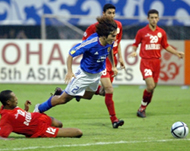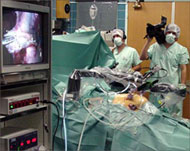Japanese engineer a robotics leap
The footballers of tomorrow will have the midfield guile of Zinedine Zidane, the finishing ability of Andriy Shevchenko and the staying power of Roy Keane.

Whether they have the sex appeal of David Beckham – or the ever-changing hairstyles – will lie entirely in the hands of their creators.
An Osaka-based consortium of robotics experts has thrown down the gauntlet to future players of the beautiful game with the confident claim that their humanoids will be so skilful that they will play mankind off the park within 50 years.
“By 2050, our aim is to beat the winners of football’s World Cup and we are very confident that we will be able to do that,” Shu Ishiguro, who heads Robot Laboratory, says.
“When we have accomplished that, we will have a society in which humans and artificial intelligence are completely in harmony.”
Ishiguro and his team are placing their faith in the offspring of VisiON.
Giant strides forward
Standing a mere 38cm tall and weighing just 2.4kg, VisiOn would not be expected to trouble the defences of most professional football teams, but he has taken some giant strides forward in recent years.
 |
|
Experts say robots will outplay |
Equipped with thighs that Steven Gerrard would be proud of, VisiON operates completely independent of human input, making its own decisions based on information that it perceives, and is able to recognise the football, approach it and then deliver a hefty kick.
It is also able to identify an opponent and shield the ball, in much the same way as a human player operates.
It might not be the fastest thing on two legs, although the developers are spending a good deal of time focusing on enabling VisiON to compete with the likes of Robert Carlos, but it does already have one very major advantage over human players.
“On top of VisiON’s head is a 360-degree vision sensor, meaning that it does not have to turn its head to see in any direction,” Ishiguro said. Having eyes in the back of its head will, unfortunately, deprive crowds of the future of that standard warning, “Man on!”
Range of tasks
Widely regarded as being the most advanced in terms of robotics in the world, Japanese experts have been working on bipedal machines capable of a broad range of tasks for several years.
The decision to push ahead with a football-playing version was in part the result of robot World Cups, the most recent of which was held in Lisbon, with the team from Tokyo’s Keio University winning the middle-size robot league and Osaka-based Systec Akazawa Co winning the humanoid league.
 |
|
VisiON is versatile: it can identify |
A remarkable 346 teams from 37 countries took part in the championships, and the next tournament, RoboCup2005, is scheduled for July in Osaka.
And while a lot of their energies are focused on football, robotics experts in Osaka are also busy developing more functional aides.
Security robots come in the shape of dinosaurs and are programmed to stomp around offices. Ankle-high vacuum-cleaning robots are on the market already and Hospi is designed to make life easier for hospital staff by providing medical charts and taking X-rays.
Robot armies?
At the 2005 World Expo, which opens in Nagoya in March, humanoid robots that can recognise faces and remember names will be on hand to give directions to visitors and help out in the child-care facilities.
One area that the researchers are not keen on tackling, however, is the concept of robot armies.
 |
|
Surgeons now use robots to carry |
“Down through human history, the weapon that has caused the most deaths has been the knife, so all technology has a risk, but what we do with this technology is up to human beings,” Ishiguro said.
“I don’t think the idea of robot armies is a good one, but that’s not my decision.”
He also dodged the question of a robot insurrection, a possibility that will not have escaped anyone working in the industry after the release of the film I, Robot.
“All these advanced technologies have an element of risk and we can warn of the dangerous aspects of robots in human society,” he shrugs, “But cars, for example, successfully collaborate with humans and have been safely intergrated into society.
Victory pose
“Everyone who saw the RoboCup could see the advantages of technology and, as long as its development is kept open to the public, there is going to be no danger,” Ishiguro added.
“But developments in the future, we must discuss at that time as a society.”
 |
|
Will a footballer made of steel |
He is clearly far happier talking about the design’s football prowess.
“For a human, it is very easy to approach a ball, estimating speed and exact distance, but that’s much harder for us to replicate in VisiON, especially when we include balance in the equation,” Ishiguro said.
But he is confident that the day will come when a footballer made of steel and wire will lift the most prestigious trophy in football.
“The important thing to remember is what you see here is just the beginning,” Ishiguro says, pointing to VisiON.
The robot, however, has already perfected its victory pose. Reminiscent of Eric Cantona in his pomp, it leans slightly to one side, hands on hips and with the ball – and the world – at its feet.